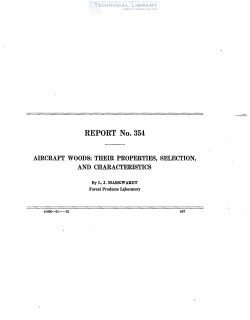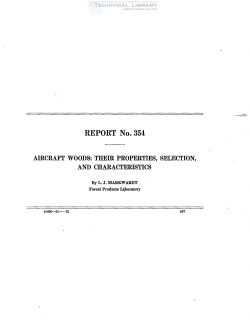naca-report-354

- Version
- 295 Downloads
- 3.03 MB File Size
- 1 File Count
- August 25, 2016 Create Date
- August 25, 2016 Last Updated
Aircraft Woods; Their Properties, Selection and Characteristics

Wood has been one of the pioneer materials in air-
craft construction. Its salient qualities—a high ratio
of strength to weight; lightness, afording readily the
size of member required to resist twisting and lateral
buckling; ease of manufacture; facility of repair with-
out specialized equipment and without highly skilled
labor; and adaptability to small-scale production—
hare always permitted it to serre usefully. Although
a lack of uniformity in the quality of wood is perhaps the
most important factor now militating against its con-
tinued use in present-day quantity production, the
existing detailed knowledge of the properties and the
causes of rariation in them, determined at the Forest
Products Laboratory and submitted to the National
Advisory Committee for Aeronautics for publication,
makes it possible to select aircraft material with assurance
and places design on a reliable basis.
Strength ralues of various woods for aircraft design
for a 15 per cent moisture condition of material and a
3-second duration of stress are presented, and also a
discussion of the various factors ejecting the values. The
toughness-test method of selecting wood is discussed, and
a table of acceptance values for sereral species is given.
This report presents, further, information on the prop-
erties of carious other native species of wood compared
with spruce, and discusses the characteristics of a con-
siderable number of them from the standpoint of their
possible application in aircraft manufacture to supple-
ment the woods that are now most commonly used.
Engineering structures are commonly designed with
the use of safe working stresses. The method is
simple, makes for safety, and gives satisfactory
results when the members are subject to simple
tension, compression, or bending. With aircraft, on
the other hand, the elements of torsion, compression,
and bending are. often combined in the same member.
| File | Action |
|---|---|
| naca-report-354 Aircraft Woods; Their Properties, Selection and Characteristics.pdf | Download |
Comment On This Post